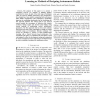168 search results - page 2 / 34 » Learning from Nature to Build Intelligent Autonomous Robots |
COLT
1991
Springer
13 years 8 months ago
1991
Springer
Applications of learning to autonomous agents (simulated or real) have often been restricted to learning a mapping from perceived state of the world to the next action to take. Of...
CEC
2010
IEEE
13 years 6 months ago
2010
IEEE
For any embodied, mobile, autonomous agent it is essential to control its actuators appropriately for the faced task. This holds for natural organisms as well as for robots. If sev...
CEC
2007
IEEE
13 years 11 months ago
2007
IEEE
—The purpose of this paper is to present a comparison between two methods of building adaptive controllers for robots. In spite of the wide range of techniques which are used for...
CIRA
2007
IEEE
13 years 11 months ago
2007
IEEE
Abstract— In human-robot communication it is often important to relate robot sensor readings to concepts used by humans. We believe that access to semantic maps will make it poss...
KI
2001
Springer
13 years 9 months ago
2001
Springer
The paper presents a new technique for extracting symbolic ground facts out of the sensor data stream in autonomous robots for use under hybrid control architectures, which compris...

